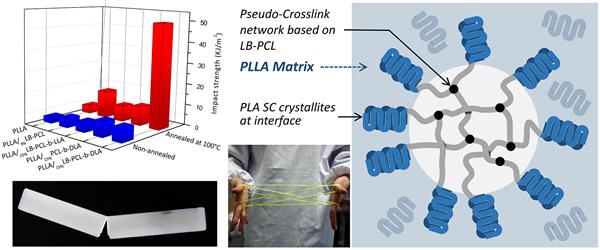
ACS Appl. Mater. Interfaces 2018, 10, 26594-26603.
We demonstrated a novel strategy to toughen poly(L-lactide) (PLLA) by constructing pseudo-cross-link networks based on chain entanglements of long-chain branched structure in the toughening phase, which were anchored by stereocomplex (SC) crystallites at the interface. The formation of pseudo-cross-link network was achieved by simple blending of the copolymer of long-chain branched polycaprolactone and poly(D-lactide) (LB-PCL-b-DLA) with PLLA without introducing any chemical cross-linking structure or nonbiodegradable component. The microscopic morphology analysis suggests that the interface-formed SC crystallites not only enhanced the interfacial interaction between LB-PCL and PLLA but also obviously increased the matrix crystallization rate. Different from those blends without SC crystallites or long-chain branched structures, nano-microgels were observed in chloroform solution of the PLLA/LB-PCL-b-DLA blend, suggesting the formation of pseudocross-link network. The pseudo-cross-link network in LB-PCL toughening phase endows PLLA a significantly improved impact toughness (49.5 kJ/m2), which is almost 13 times than that of neat PLLA. Moreover, matrix crystallinity and spherulite size of the PLLA matrix also play significant roles in toughening. Only sufficiently crystallized PLLA with proper spherulite size can effectively trigger the matrix shear yielding, meanwhile, facilitate the energy dissipating.